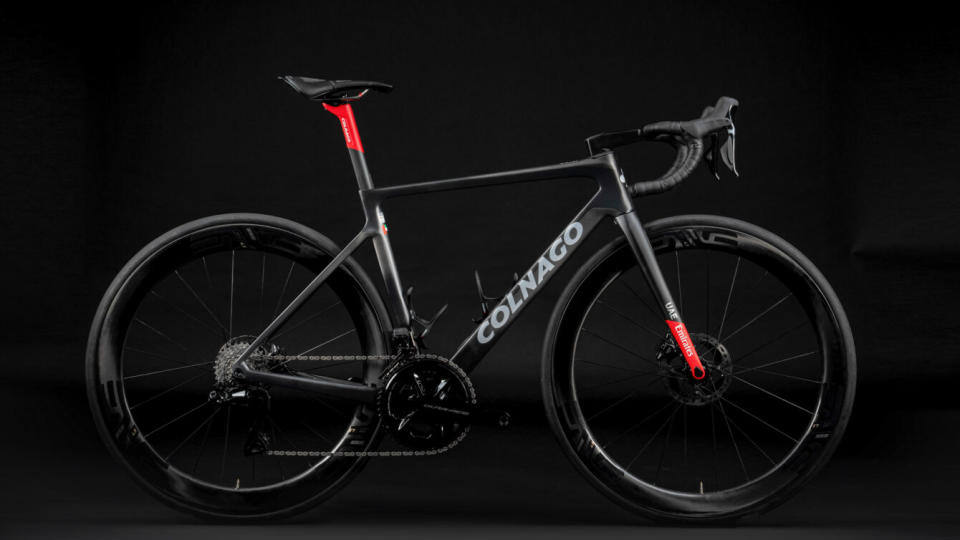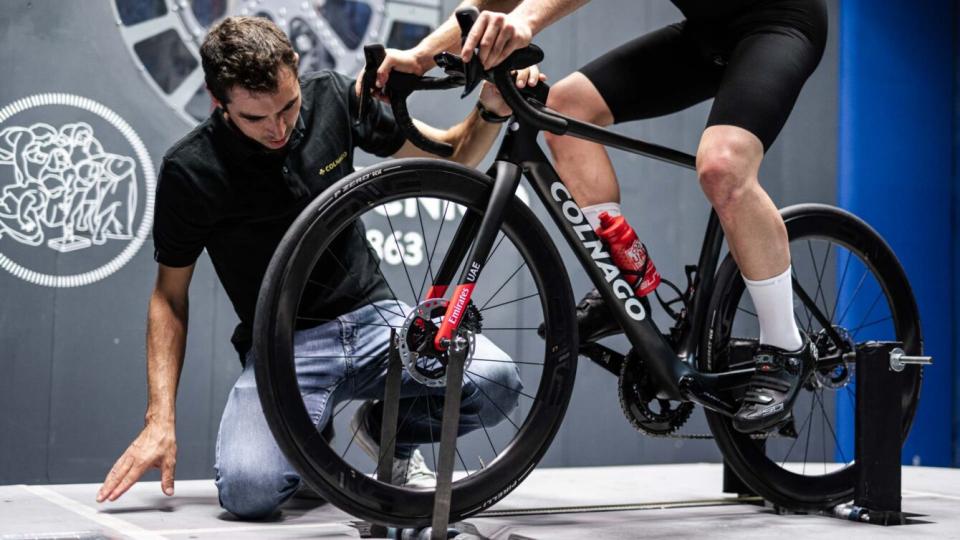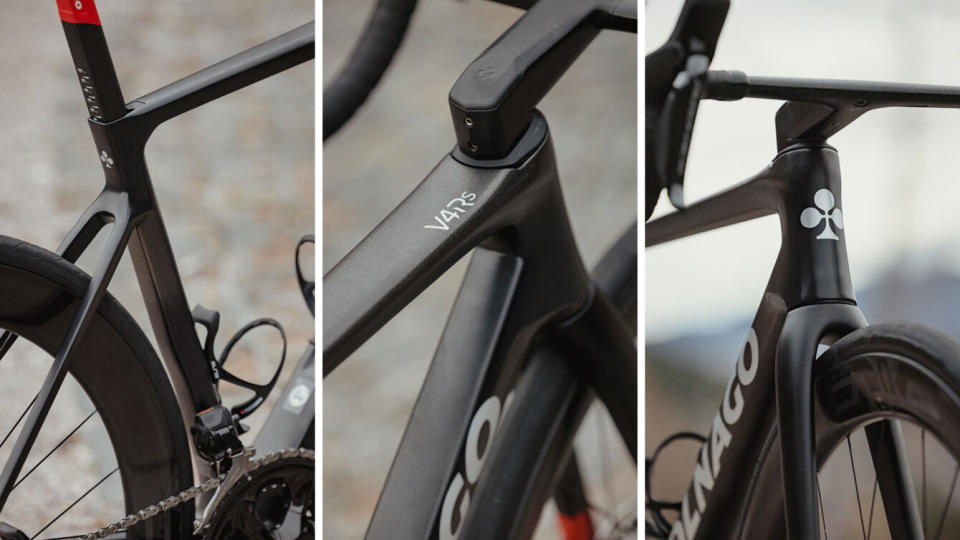Colnago debuts new V4Rs flagship road racer
This article originally appeared on Velo News
Colnago has unveiled the latest iteration of its V-series aero all-round road racer, the V4Rs. Purpose-built as a road-racing bike first and foremost, Colnago claims the V4Rs is not only more aerodynamic than the V3Rs that came before it, but it's also a bit lighter (sort of) and "dynamically" stiffer.
Er, what? Needless to say, there's some explanation required here.
This story originally appeared on CyclingTips.
A familiar form
Visually speaking, the V4Rs doesn't look all that different from the V3Rs. As is now the norm for semi-aero all-rounders these days, the bike once again uses truncated airfoil tube shapes to strike a balance between aerodynamic and structural efficiency. The profile is virtually unchanged, with just a modest slope in the top tube, seatstays that are only slightly dropped, and tube paths that are generally dead-straight from end to end. Tube shapes themselves have also been nipped and tucked, but there are no dramatic changes to note so it's definitely more an evolution than a revolution.

It says a lot, then, that the most obvious visual change is in the cockpit. Whereas the V3Rs used a two-piece setup, the V4Rs uses the same CC.01 one-piece carbon fiber setup Colnago also uses on the C68. Cable routing is fully hidden, of course, and also fully internal, running through the inside of the flattened bar tops and integrated stem extension before taking a downward turn into the newly oversized upper headset assembly.
Colnago didn't mention anywhere in the V4Rs's press materials if the modified-for-Colnago Granite Stash RCX multi-tool used on the C68 will also fit the V4Rs, but my guess is it would. Colnago does make a big deal out of the V4Rs's new 3D-printed out-front computer mount, though, which admittedly does look pretty slick. Unfortunately, it's only offered for the second-generation Wahoo Fitness Bolt for now.
Also read: Pro bike gallery: Clara Honsinger's national champion edition Cannondale SuperSix Evo CX
Stronger. Faster. Better.
Despite the modest changes in shape, Colnago nonetheless claims the V4Rs is a fair bit more aerodynamic than the V3Rs.
According to data supplied by Colnago, the V4Rs requires 5.2 W less power to maintain 50 km/h than the V3Rs for the bike alone with the same wheels, using the industry-accepted Weighted Averaged Drag (WAD) protocol that accounts for multiple yaw angles. If you add in a rider, that gap supposedly jumps to 13.2 W - a significant improvement for sure.

However, it's unclear just how much of that is from the frameset itself, and how much is due to that CC.01 handlebar-and-stem setup (Colnago didn't provide that data). Interestingly, however, we do know that the computer mount accounts for 0.75 W of savings on its own.
Colnago did provide details on the new frame weight, which is essentially unchanged. In fact, at 798 g for a 50s size - roughly equivalent to a traditional 54 cm - the V4Rs is actually 3 g heavier than the V3Rs. That said, the new fork and CC.01 cockpit are lighter than what Colnago used on the older bike, so there's a reported net loss of 47 g.
More interesting are Colnago claims regarding chassis stiffness.

Using the traditional Zedler bench tests (widely used by various bike brands and German publication Tour Magazin), the V4Rs comes in slightly less stiff than the V3Rs, falling even at the bottom bracket, but 5-10% lower at the head tube. However, Colnago insists the widely-used Zedler tests don't fully reflect the stresses placed on bikes in the real world, and instead presents its own measurement called Real-Dynamic Stiffness (that hyphen is from Colnago, not me).
According to Colnago, the company's so-called RDS-SP (Real-Dynamic Stiffness--Sprint Position) and RDS-ST (Seated Position) tests more accurately reflect the out-of-plane forces to which a bike is subjected to while riding. Colnago isn't willing to provide more detail at the moment (citing pending patent status), but here's how the company describes RDS:
Sprint position: a combination of loads applied both on the handlebar and on the bottom bracket, with both component laying on the front triangle plane and normal to the frame plane, aimed to simulate the flexural and torsional stresses at oscillating cambers.
Seated position, loads are applied only on the same plane of the front triangle to replicate the all-round riding.
Needless to say, the V4Rs does better in those tests, boasting a 4% improvement in sprint-position stiffness and a 5% jump in seated-position stiffness. Even if you take Colnago's claims at face value (including the validity of the RDS protocol in general), neither of those increases are groundbreaking, though it's good to see improvements nonetheless.
Long-time Colnago fans will perhaps take more interest in the changes in frame geometry.
Whereas the V3Rs was offered in eight sizes, the V4Rs reduces that to seven, albeit covering roughly the same total range as before. Steering geometry is unchanged, but whereas the chainstay length once varied from 408 mm on the smallest frame size to 414 mm on the largest one, it's now 408 mm across the board. Bottom bracket drop is now pegged at 72 mm for all sizes, as compared to the 67-72 mm figure of the V3Rs.
Overall, that suggests a bit more agility for the larger sizes, and a bit more stability for smaller ones. Going along with those seven frame sizes will be fourteen different length-and-width combinations of the CC.01 cockpit.
Regardless of your opinions on the handling changes, the updates to other dimensions aren't likely to be as controversial.
Colnago has tweaked the sizing of the V4Rs such that the stack and reach progression is more linear across the range so that prospective buyers shouldn't have to do as much number crunching to figure out what size might work best for them. In addition, there's also a more linear relationship between seat tube length and reach for the same reason.
One very good highlight: Colnago is specifically pointing out the V4Rs's frame toughness - in other words, how well the frame can take a hit. There were no specifics outlined there aside from pointing out an improvement in the seatstays especially, or where things were in that regard with the V3Rs. Nevertheless, I think it's a good thing to see durability mentioned in general.
Unfortunately, Colnago didn't seem to have much to say in terms of the V4Rs's ride quality. That said, the V3Rs was widely considered to be pretty comfortable as far as all-round aero road racers are concerned, and given the lack of any dramatic changes in frame shaping or weight, I don't expect any major changes there. Tire clearance has gone up to 32 mm, though, so if you're interested in a road racing bike but still want a cushy ride, you've got options here.
Other things to mention? Like on the C68, the V4Rs comes stock with CeramicSpeed STL solid-lube headset bearings, largely to help lengthen the service intervals since those bearings aren't nearly as easy to access as they once were before the rise of internal routing.
Oh, and let's not forget pricing. Needless to say, the V4Rs is expensive, but not outrageously so (relatively speaking, of course). And Colnago is keen to point out the V4Rs is still a fair bit less expensive than a Pinarello Dogma F.
Several different builds are available (including Campagnolo), but the flagship version with a Shimano Dura-Ace Di2 wiredless electronic groupset (with power meter), Enve SES 3.4 carbon clinchers, and a Colnago CC.01 cockpit will cost EUR15,260. If you want to start with a bare frameset so you can outfit it yourself, a "frame kit" will run you EUR5,250. Whichever way you go, the V4Rs is disc-only and electronic-only.
More information can be found at www.colnago.com.
For exclusive access to all of our fitness, gear, adventure, and travel stories, plus discounts on trips, events, and gear, sign up for Outside+ today.

